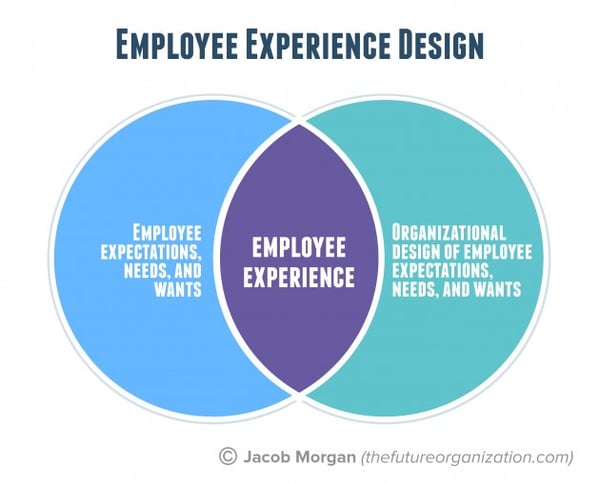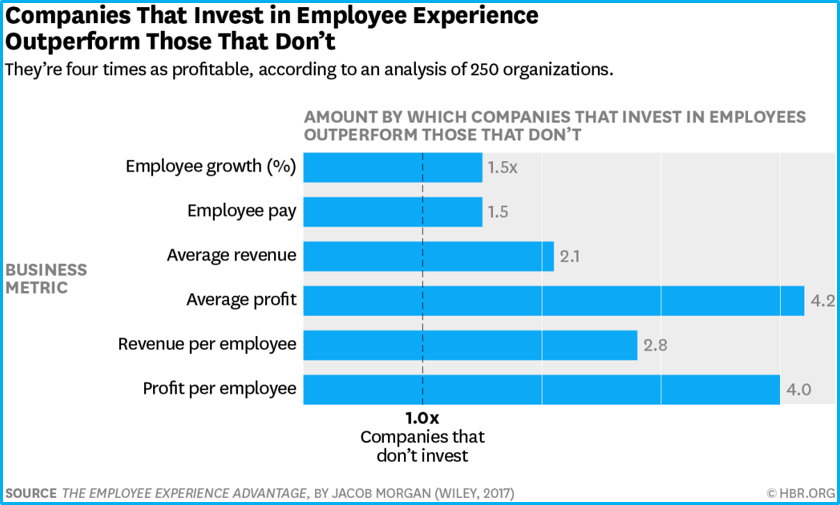Employee experience (EX) is our journey within the workplace. It must include the entire organizational journey; starting from the application process and continuing after being separated. This includes recruitment, on-boarding, our role within the organization, how well we understand the goals of the business, how the company rewards us and how it develops us to be the best that we possibly can be.
Is it optional?
Certainly not. We will have an experience anyway. Whether it is a good one that we enjoy for many years or a bad one we want to quit quickly will make or break a business in the long run.
How?
Employee Experience is a bottom-up concept
The key to delivering a great EX is enabling us to feel and be connected.
It's our journey of making use of the various apps, systems, platforms, and information we need to do our job.
Physically and digitally, how does the organization support our professional objectives and treat us like a valued colleague?
We want to feel that our work matters and that our employer cares about us.
Nobody wants to be just a cog in the machine.
Reams of research all point to one formula: a well-crafted EX leads to better EE.
Employee Engagement is the effect. Employee Experience is the cause.
It’s really just that simple.
But maybe not that easy.
Designing the Employee Experience
If we really want to find ways to sustain higher levels of Employee Engagement (EE) and performance, we need to design the work experience to be more engaging (when I write ‘we’ I mean employers AND employees together).
Most people don't stop to think about it, but experiences are really one of the main things that make all of us human.
The challenge we have to overcome today is how to shift our relationship with work from feeling like a physical purchase, where satisfaction starts to decline over time, to an investment in an experience, where our satisfaction increases over time.
A good start is creating organizations where we truly want to be instead of need to be.
The wonderful book “The Employee Experience Advantage” by Jacob Morgan shows proven and benchmarked ways to get there.
“I view employee experience as something that creates engaged employees but focuses on the cultural, technological, and physical design of the organization to do that. As the intersection of employee expectations, needs, and wants and the organizational design of those expectations, needs, and wants.” - Jacob Morgan

One crucial thing to keep in mind is that EX can't be created unless the organization knows us its employees.
Getting to Know the Employees
Every leading organization has thorough feedback mechanisms that connect the voice of the employee to the decisions that the organization makes. Without this bridge there is no such thing as a great EX.
Feedback in an organization can happen in only two ways: in person or through technology.
In person is the preferred option, but what if the workforce is geographically disbursed and mainly working on-the-go?
That’s where technology can act as the glue and the nervous system that powers the organization.
Ideally, a technology that actually looks like it is designed for us humans and not for rocket scientists or developers.
We have access to so many amazing technologies and platforms in our personal lives, but for some reason when we show up to work, we are stuck using the same tools we used to use decades earlier.
More Email anyone?
We really want and need something more stylish, flexible, modern, and attractive.
But consumer-grade technology such as Beekeeper is only one of three components of Jacob Morgan’s proven and tested "Employee Experience Equation".

Culture has the Highest Impact on EX
Based on Jacob Morgan’s research culture has an impact share of 40% on the overall EX - and it's the most challenging to execute on.
Because culture deals more with the human side of things.
Now the good news is that when we start working at an organization, we are already engaged. Remember that ‘first day at work’ feeling?
It is about retaining and building on the commitment, energy and desire to do a good job that characterizes most of us, to maximize individual and organizational performance.
So how to sustain our engagement that’s the real challenge.
First step is to measure our engagement.
How often?
That's something we the people should control and be able to do when and where we want as often as we want.
Organizations need to understand that this is a dynamic and fluid thing that changes constantly.
We are not light switches that are either on or off.
Anything related to us should be measured continuously. Perhaps the organization has short single‐question pulse surveys weekly, monthly culture snapshots, or semi-annual engagement reviews.
And then comes what is missing from many organizations:
Yes, they ask us.
Yes, they acknowledge us.
But do they really act on the ideas, feedback, and opinions that we are willing to share?
And it's not just taking action but also doing so transparently within a reasonable timeline.
Employee Experience is NOT equal to Employee Engagement
Despite the fact that high EE is the end goal, many organizations fail to recognize that EX is the means to that end.
They often only pay attention to results from engagement surveys rather than proactively designing and managing EX.
They are looking at effects (engagement) without causes (the experiences that lead to certain levels of engagement).
The hard truth is that we employees can engage ourselves much better than an HR program can.
And yet it's in the interest of organizations to improve levels of EE, so they try.
And so they should.
Let’s think of EX as an ongoing and never-ending back‐and‐forth interaction between us the employees and the organization. Like a dance where both partners need to take the appropriate steps for it to make sense. Except in this tango, the music never stops, and neither does the dancing!
This concept of an infinity loop shows an ongoing relationship or a continuum between us and the organization. There is no break and it's designed to flow a bit like water smoothly around the loop.

Notice that we make up half of the feedback loop and the organization makes up the other half.
This is quite different from most traditional models, which see the organization own 100 percent of the employee experience while employees have no pro-active role in it.
Only half of the equation is how the employer could increase the employee’s engagement.
The other half is pertaining to how WE could increase our own engagement. Forgetting that second half is the biggest mistake organizations make in EE.
It always takes two to tango!
No single party can do it alone and no single component can get to its maximum potential without having the support of the other two. Culture, technology and physical working space must all be taken care of together.
The reason why so many organizations around the world are struggling with not only improving EE but also justifying the required investments:
They are stuck focusing on just a small part of the big picture, and even that small part isn't being executed on well.
Thinking of the overall EX in this type of equation helps organizations realize that all three components are crucial and have a much greater impact than the sum of their individual parts.
Struggling with profitability vs. our peers?
EX does impact profitability as long as the approach is about making the right choices and connecting things up across the business in a way which is right for the context of operations. Not simply just to make us people happy or satisfied, but to deliver the right conditions for us to thrive - consistently.
Organizations can start making incremental changes from where we are and with what we’ve got.
You see, we employees have so many excellent tech experiences in our personal lives that we expect similar technology in our professional lives too.
Organizations can’t afford not to invest in mobile technology that is accessible for everyone on the team. It’s a necessary component of EX.
Through research we know that there is an indisputable correlation between EX, customer experience (CX) and, ultimately, business performance.
Savvy leaders got it and implemented award-winning technology for their operations already to sharpen their competitive edge.

Curious to learn about some Best Practices to get to higher Employee Engagement through better Employee Experiences?
Download our eBook:



